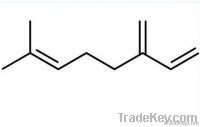Natural Myrcene 75% CAS 123-35-3
- Payment Type: T/T, Western Union
Product Description
Appearance: colorless to light yellow liquid
Organoleptic properties: has a pleasant light smell of balsam
Myrcene, or β-myrcene, is an olefinic natural organic compound. It is classified as a hydrocarbon, more precisely as a monoterpene. Terpenes are dimers of isoprene, and myrcene is one of the most important. It is a component of the essential oil of several plants including bay, ylang-ylang, wild thyme, and hops.It is produced mainly semi-synthetically from myrcia, from which it gets its name. It is a key intermediate in the production of several fragrances. α-Myrcene is the name for the structural isomer 2-methyl-6-methylene-1, 7-octadiene, which is not found in nature and is little used. Use in fragrance industry Myrcene is an important intermediate used in the perfumery industry. It has pleasant odor, but is rarely used directly. It is also unstable in air, tending to polymerize. Samples are stabilized by the addition of alkylphenols or tocopherol. It is thus more highly valued as an intermediate for the preparation of flavor and fragrance chemicals such as menthol, citral, citronellol, citronellal, geraniol, nerol, and linalool. Treatment of myrcene with hydrogen chloride gives geranyl chloride, neryl chloride, and linalyl chloride. Treatment of these compounds with acetate gives geranyl acetate, neryl acetate, and linalyl acetate, respectively. These esters are then hydrolyzed to the corresponding alcohols. Myrcene is also converted to myrcenol, another fragrance found in lavender, via uncatalyzed hydroamination of the 1, 3-diene followed by hydrolysis and Pd-catalyzed removal of the amine. As 1, 3-dienes, both myrcene and mycenol undergo Diels-Alder reactions with several dienophiles such as acrolein to give cyclohexene derivatives that are also useful fragrances. Other models:
gum rosin, litsea cubeba oil, citronella oil, wormwood
oil, Alpha-pinene, beta-pinene, turpentine oil, pine
oil, terpineol, dihydromyrcenol, terpene resin, gamma-terpinene, rosemary
oil, white camphor oil, tea tree oil, fennel oil, lavender
oil, pine needle oil, camphor oil, cinnamon oil, star aniseed
oil, menthol crystal, borneol, lemon oil, linaly acetate, citral, fennel alcohol, spikenard oil, peppermint oil, eucalyptus oil, cinnamic aldehyde, myrcene, basil oil, lemongrass oil, garlic oil, ginger oil, anethole, and so on.
High quality with competitive price.
Please feel free to contact us.
Organoleptic properties: has a pleasant light smell of balsam
Myrcene, or β-myrcene, is an olefinic natural organic compound. It is classified as a hydrocarbon, more precisely as a monoterpene. Terpenes are dimers of isoprene, and myrcene is one of the most important. It is a component of the essential oil of several plants including bay, ylang-ylang, wild thyme, and hops.It is produced mainly semi-synthetically from myrcia, from which it gets its name. It is a key intermediate in the production of several fragrances. α-Myrcene is the name for the structural isomer 2-methyl-6-methylene-1, 7-octadiene, which is not found in nature and is little used. Use in fragrance industry Myrcene is an important intermediate used in the perfumery industry. It has pleasant odor, but is rarely used directly. It is also unstable in air, tending to polymerize. Samples are stabilized by the addition of alkylphenols or tocopherol. It is thus more highly valued as an intermediate for the preparation of flavor and fragrance chemicals such as menthol, citral, citronellol, citronellal, geraniol, nerol, and linalool. Treatment of myrcene with hydrogen chloride gives geranyl chloride, neryl chloride, and linalyl chloride. Treatment of these compounds with acetate gives geranyl acetate, neryl acetate, and linalyl acetate, respectively. These esters are then hydrolyzed to the corresponding alcohols. Myrcene is also converted to myrcenol, another fragrance found in lavender, via uncatalyzed hydroamination of the 1, 3-diene followed by hydrolysis and Pd-catalyzed removal of the amine. As 1, 3-dienes, both myrcene and mycenol undergo Diels-Alder reactions with several dienophiles such as acrolein to give cyclohexene derivatives that are also useful fragrances. Other models:
gum rosin, litsea cubeba oil, citronella oil, wormwood
oil, Alpha-pinene, beta-pinene, turpentine oil, pine
oil, terpineol, dihydromyrcenol, terpene resin, gamma-terpinene, rosemary
oil, white camphor oil, tea tree oil, fennel oil, lavender
oil, pine needle oil, camphor oil, cinnamon oil, star aniseed
oil, menthol crystal, borneol, lemon oil, linaly acetate, citral, fennel alcohol, spikenard oil, peppermint oil, eucalyptus oil, cinnamic aldehyde, myrcene, basil oil, lemongrass oil, garlic oil, ginger oil, anethole, and so on.
High quality with competitive price.
Please feel free to contact us.
Contact Information
- Contact Person: Ms. Lily Zhang (Sales)
- Company: Jiangxi Global Natural Spice Co., Ltd.
- Address: No.89, Wenshan Road,South Industrial Park, Jishui County,Jiangxi Province, Ji'an, Jiangxi, China
- Zip/Postal: 343000
- Telephone: 86-7968106598
- Fax: 86-7968116585
Company Profile
- Jiangxi Global Natural Spice Co., Ltd.
- [ China ]
-

-
We are well known as one of the old enterprises with over 10 years of experience in the production, development and deep processing of natural spice oil. Our raw materials are wild spice plants and planted natural vegetation. Our products are natural spice, monomer spice and essential oil, including ginger oil, dried tangerine peel oil, cassia oil, citronella oil, garlic oil, star anise oil, ta...
Basic Information
- Business Type: Manufacturing
- Company Products / Services: spice, spice oil, essential oil, plant extrat, herbs extracts
- Year Established: 2004
- Number of Employees: 6-10
- Website: www.jxhqxl.com


